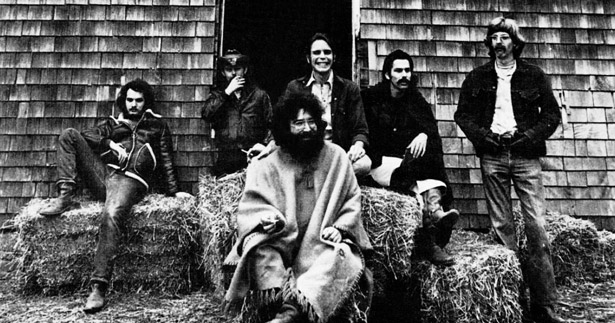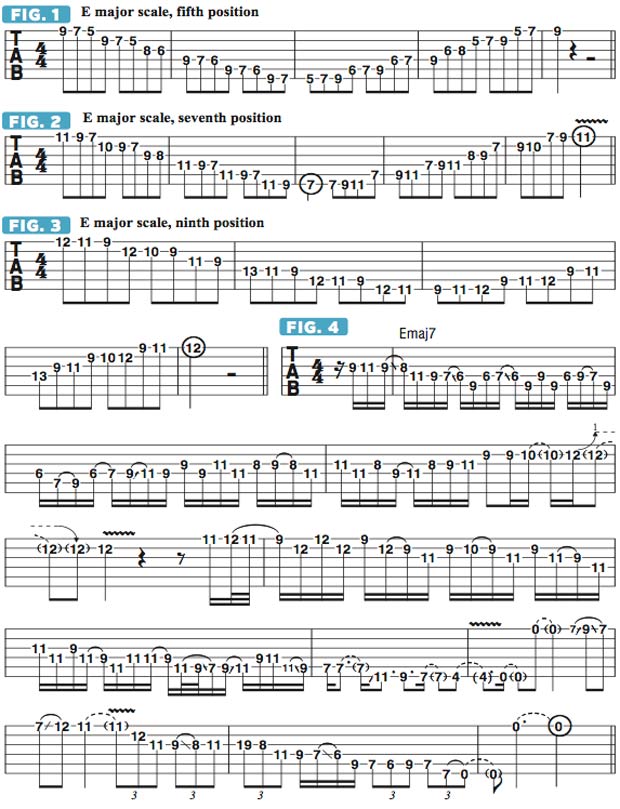How to Solo on the Grateful Dead’s “Eyes of the World”

Last month, we explored a few different approaches to rhythm guitar jamming and soloing on the classic Grateful Dead song “Eyes of the World.”
The song is played in the key of E major and begins with an extended one-chord vamp and groove on an Emaj7 chord, over which guitarist Jerry Garcia adds solo improvisations based on the E major scale (E F# G# A B C# D#).
Later in the tune, during the guitar solo section, this one-chord vamp is broadened to a two-chord vamp—Emaj7 to Bm—and then for the song’s outro, the band adds a third chord and plays Emaj7-Bm-A for Garcia to solo over. In all three instances, the guitarist demonstrates incredible inventiveness and a clear sense of melody, relying heavily on the E major scale to play over Emaj7.
We’re confining our focus here to soloing over the Emaj7 vamp, and last month we left off by combining two positions and patterns of the E major scale: the first, or “open,” position and second position. This month, we’ll venture further up the fretboard and explore the E major scale patterns in fifth, seventh and ninth positions.
For all three of these patterns, I mostly use a three-notes-per-string fingering approach, except on the G string, for which only two notes are fretted. Some of the fingerings span four frets, so some stretching and reaching is required, but nothing too crazy or arduous. FIGURE 1 illustrates the E major scale played in fifth position, descending and ascending. I begin on a high C# note, fretted with the pinkie, and then descend to B and A, fretted with the middle and index fingers. As I move across to each lower string, I try to maintain the pinkie-middle-index fingering as much as possible. Use alternate (down-up) picking throughout, striving for clear articulation of each note.
FIGURE 2 shows the E major scale played in seventh position, starting on a high D# note at the 11th fret, fretted with the pinkie. Descend through two and a half octaves down to the low B note on the sixth string’s seventh fret, then ascend back to the high D#, striving to keep your fret hand relaxed throughout (minimal tension). FIGURE 3 illustrates the E major scale played in ninth position, starting on the high E root note on the high E string’s 12th fret. Play this pattern descending and ascending, and be sure to memorize all three scale positions/patterns.
Now let’s focus on combining these scale positions while soloing. FIGURE 4 presents an 11-bar improvised solo over the Emaj7 vamp, starting in ninth position but immediately shifting down to seventh and then fifth-sixth position by beat two of bar 1. On beat two of bar 2, I shift positions again, by sliding my pinkie up the D string from the ninth fret to the 11th, and then remain in ninth position throughout bars 3–7. Bars 7–10 shift the rhythm of the lines from straight 16th notes to more syncopated melodies while also moving more quickly between the various scale positions. Try experimenting with these approaches in your own solo improvisations.
In Deep, FIGURE 1
In Deep, FIGURE 2
In Deep, FIGURE 3
In Deep, FIGURE 4

Get The Pick Newsletter
All the latest guitar news, interviews, lessons, reviews, deals and more, direct to your inbox!
Guitar World Associate Editor Andy Aledort is recognized worldwide for his vast contributions to guitar instruction, via his many best-selling instructional DVDs, transcription books and online lessons. Andy is a regular contributor to Guitar World and Truefire, and has toured with Dickey Betts of the Allman Brothers, as well as participating in several Jimi Hendrix Tribute Tours.
“There are so many sounds to be discovered when you get away from using a pick”: Jared James Nichols shows you how to add “snap, crackle and pop” to your playing with banjo rolls and string snaps
Don't let chord inversions bamboozle you. It's simply the case of shuffling the notes around








![Joe Bonamassa [left] wears a deep blue suit and polka-dotted shirt and plays his green refin Strat; the late Irish blues legend Rory Gallagher [right] screams and inflicts some punishment on his heavily worn number one Stratocaster.](https://cdn.mos.cms.futurecdn.net/cw28h7UBcTVfTLs7p7eiLe.jpg)


